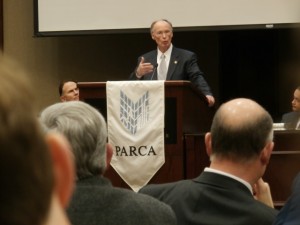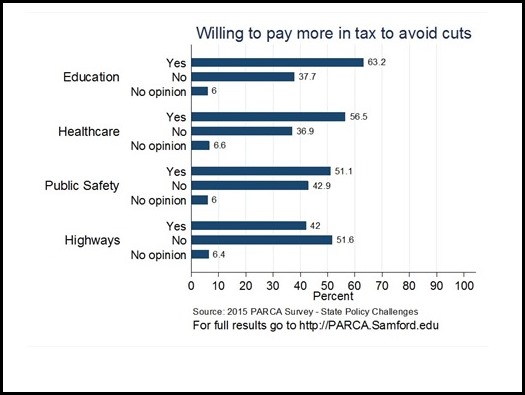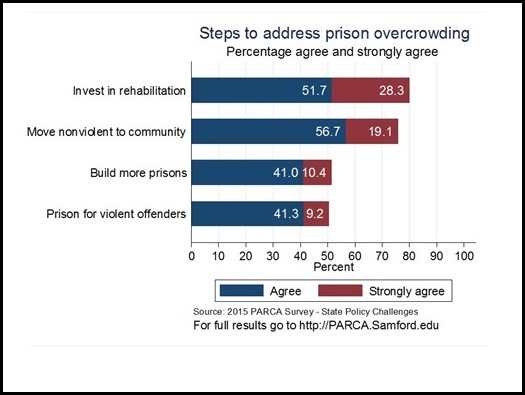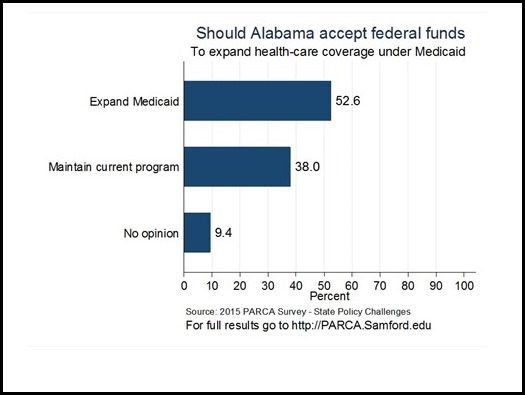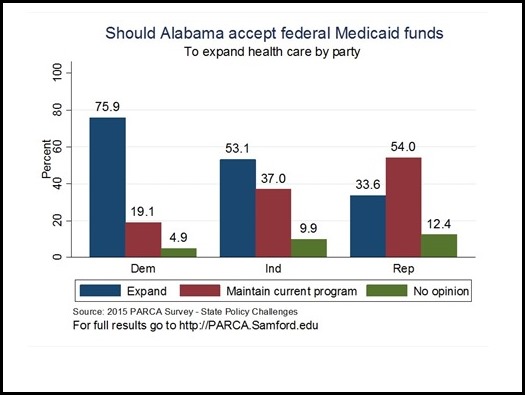 Loading…
Loading…
In January 2016, The Public Affairs Research Council of Alabama conducted its annual poll of public opinion. This is the 10th year of the survey. This year, the survey focuses on revenue and spending in state government. The survey touches on multiple topics: taxes, education, Medicaid, highways, public safety, courts, state parks, and others. The complete survey results are posted in presentation form above. Text of the questions and results are presented at the bottom of this post. Highlights are featured below. An in-depth audio-visual presentation of the of the results is also available here.
The survey of 466 Alabamians was conducted between January 4 and January 21. Randolph Horn, Samford University Professor of Political Science and Samford’s Director of Strategic and Applied Analysis, collaborated with PARCA on the design of the survey and directed the polling operation. The results were weighted to reflect the demographic makeup of the state.
Respondents ranked education as the most important investment the state makes followed by health care, public safety, and highways. All four areas are underfunded in Alabama, according to a majority of respondents.
In the areas of education and health care, majorities said they would be willing to pay more in taxes the avoid cuts or achieve adequate funding. In the areas of public safety and highways, less than a majority would be willing to pay more in taxes to avoid cuts or achieve adequacy.
A majority said the state needs more revenue to support state services.
Respondents perceive that state and local taxes fall more heavily on lower-income Alabamians than higher income range. A plurality of respondents say that lower-income residents pay too much in state and local taxes and a majority say that that those in the upper-income group pay too little.
Given options for how the state might increase tax revenue, the only option receiving majority support was to make the state income tax more progressive by increasing the percentage of income that high-income individuals pay in state income taxes.
Looking more closely at more targeted areas of state investment, a majority of respondents said state parks and state troopers are not adequately funded. Opinions were more mixed when it came to state courts and driver’s license offices.
But none of those areas received majority support when respondents were asked if they were willing to pay more in taxes to support them.

A majority of respondents support expanding Medicaid to cover more people. The same question was asked last year and received the same level of support.

On most questions, Alabamians, whether Democrat or Republican, black or white, are relatively united in opinion. However, the response to the Medicaid question does show a partisan divide with majorities of Democrats and independents supporting expansion while a majority of Republicans support maintaining the system as it is.

Strong majorities felt that officials in Montgomery did not care about their individual opinions. This is consistent finding over time.
That distrust of elected officials is perhaps reflected in respondents’ support for earmarking state revenue. Earmarking is defined as designating revenue raised from a particular source to be spent for a particular purpose. An example would be Alabama’s earmarking of income and sales tax revenue for public education.
When it comes to education spending in Alabama, respondents had particularly strong opinions: 69 percent said the education budget should be kept separate from the budgets funding other state services; 70 percent said too little is being spent on education; over 80 percent said the level of funding for schools makes a difference in educational quality; 86 percent said that the state should make up the difference if a community is too poor to support schools adequately.
In terms of what areas are most need of investment in education, respondents showed the strongest support for spending more on teacher’s salaries, with 71 percent supporting increasing teacher salaries. Increasing spending on technology infrastructure, hiring more classroom teachers, school security, classroom technology, and music and the arts all received majority support.
The full text of questions and results is included below.
 Loading…
Loading…
 Loading…
Loading…





